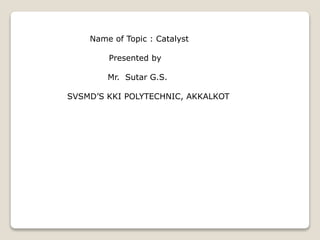
Catalyst
- 1. Name of Topic : Catalyst Presented by Mr. Sutar G.S. SVSMD’S KKI POLYTECHNIC, AKKALKOT
- 2. INTRODUCTION 1.Catalyst plays an important role in chemical reaction. 2.Catalytic reagents are better than ordinary reagents. 3.Catalyst mainly used to prevents the environmental 4.pollution. It helps us to achieve the goal of green chemistry catalyst is a substance which alters the speed (rate )of a chemical reaction without itself taking part in the chemical reaction. A + B ---CATALYST---------> PRODUCT The process of using a catalyst to alter the speed of a chemical reaction is called as catalysis
- 3. a chemical reaction A + B --CATALYST---------> PRODUCT reactant side Product side Ex: 2KClO3 --- MnO2 ------→ 2KCl +3O2 Decomposition of potassium chlorate is very slow under normal conditions. When a small amount of manganese dioxide is added the rate of decomposition of potassium chlorate increases. In the above reaction, MnO2 acts as a catalyst. The reaction is called as catalysis.
- 4. TYPES OF CATALYST: There are two types of catalysts (i) Positive catalyst (ii)Negative catalyst 1. POSITIVE CATALYST :A catalyst which increases the speed of the reaction is called positive catalyst and The phenomenon is known as positive catalysis. Various examples are given below Iron is used as a positive catalyst in the synthesis of ammonia by Haber’s process. N2 (g)+ 3H2 (g)----- Fe(S)------→ 2NH3(g)
- 5. Nitric oxide is used as the catalyst in the lead chamber process SO2(g) +O2(g)------ NO2(g)---→ SO3(g 2. NEGATIVE CATALYST: A catalyst which decreases the speed of the reaction is called negative catalyst and the phenomenon is known as negative catalysis. The decomposition of hydrogen peroxide is decreases in the presence of glycerin 2H2O2-------- Glycerin ---------→ 2H2O+O2 3 Auto Catalyst :one of the product act as catalyst ,which alter the rate of reaction
- 6. Types of catalytic reactions or catalysis catalysis HOMOGENEOUS CATALYSIS HETEROGENEOUS Catalysis Homo= same phase Hetero = Different phase
- 7. 1.HOMOGENEOUS CATALYSIS :If the catalyst and the reactants are in the same phase, then it is called as homogenous catalysis. In the lead chamber process Oxidation of sulphur dioxide into sulphur trioxide with oxygen in the presence of nitric oxide is used as the catalyst SO2 (g) + O2 (g)---------- NO2(g)--------------------> SO3(g) 2.HETEROGENEOUS CATALYSIS: If the catalyst and the reactants are in the different phase, then it is called as heterogeneous catalysis. Some of the examples of heterogeneous catalysis ,synthesis of ammonia by Haber’s process. N2(g)+ 3H2(g)-------- Fe(s) --------- 2NH3
- 8. Promoters: Promoter is a substance which increases the activity of the catalyst. The activity of a catalyst can be increased by addition of a small quantity of other material. These substances which, though itself not a catalyst, promotes the activity of a catalyst is called a promoter. Some examples of the promoters are given below. In the Haber’s process for the synthesis of ammonia, traces of molybdenum increase the activity of finely divided iron which acts as a catalyst N2 + 3H2 ----.Fe (solid) , Mo (promoter)----→ 2NH3 CATALYTIC POISONS: Catalytic poison is a substance which lowers the activity of the catalyst. A substance which destroys the activity of the catalyst is called a poison and the process is called catalytic poisoning. The iron catalyst used in the synthesis of ammonia in Haber process is poisoned by H2S. N2 +3 H2 ------ Fe (solid),-(Poisoned by H2S)-----------→ 2 NH3
- 9. General characteristics of a catalyst: 1. The catalyst remains unchanged at the end of the reaction. But it may undergo physical change. 2. Only a small quantity of catalyst is generally needed. 3. A catalyst cannot initiate a reaction. 4. The function of a catalyst is only to alter the speed of the reaction 5. A catalyst does not alter the position of equilibrium in a reversible reaction. 6. A catalyst cannot change the nature of the products obtained in a reaction.
- 10. APPLICATIONS OF CATALYST: In order to increase the yield of products and also to increase the rate of reaction, catalysts are employed for various applications in industries. 1.In the Haber’s process for the synthesis of ammonia, finely divided iron which acts as a catalyst. N2 + 3H2-------- Fe (solid), Mo (promoter) ----------------- 2NH3 2.In the contact process of preparation of sulphuric acid, platinum is used as a catalyst. 2SO2 (g) +O2(g)---- Pt ----→ 2SO3(g) 3. In the manufacture of ethyl alcohol from sucrose, the enzyme Invertase and zymase are used as catalyst. C12H22O11 + H2O ------→ C6H12O6 + C6H12O6
- 11. 4. In the manufacture of hydrogen chloride from hydrogen and chloride, activated carbon is used as catalyst. H2 + Cl2 --------→ 2HCl 5. In the manufacture of methyl alcohol from CO and H2, zinc oxide is used as Catalyst. CO + 2H2 ---- ZnO----→ CH3OH 6. In the refining of petroleum, phosphoric acid is used as a catalyst. 7. In the cracking of petroleum fractions, silica is used as a catalyst. 8. In the hydrogenation of vegetable oil, nickel is used as a catalyst.